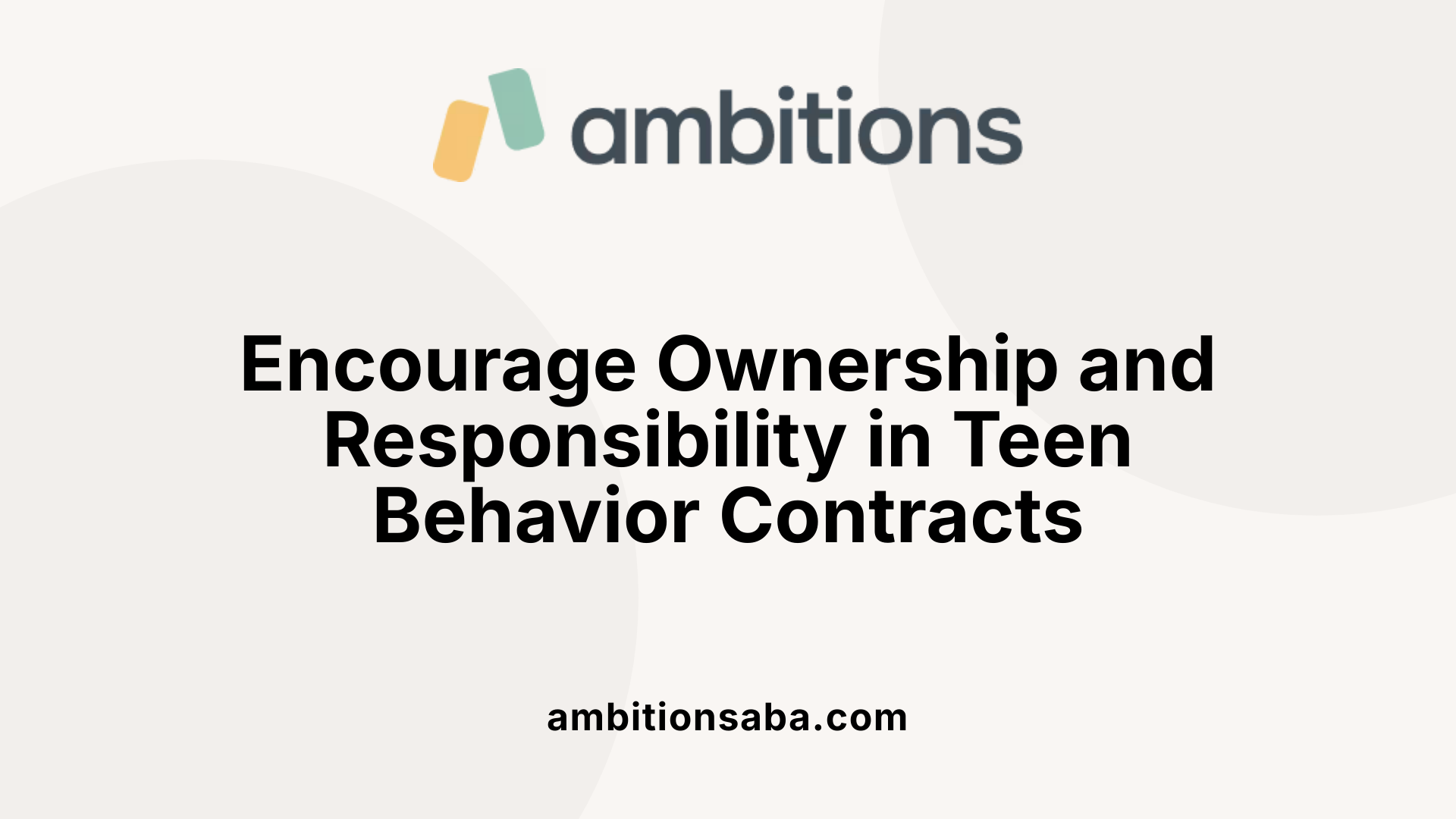Navigating Breaks Effectively in Therapeutic Settings
Understanding Behavior Contracts for Older Children
Creating effective behavior contracts for older children is a strategic approach to fostering responsibility, accountability, and positive habits. By clearly outlining expectations, rewards, and consequences, parents and educators can guide children towards self-control and moral development. This article explores the key components, preparation steps, and best practices for designing behavior contracts tailored to the needs of older children and teens.
Key Components of a Behavior Contract
An effective behavior contract for older children should include several essential elements to ensure clarity and success. First, it must clearly specify the targeted behaviors that the child is expected to demonstrate, such as completing homework, practicing good hygiene, or following rules. Second, measurement criteria should be outlined so both parent and child know how progress will be monitored, like checking off completed chores or tracking specific habits.
Third, the timing for behaviors is important; the contract should specify when and how often behaviors are expected to occur, such as daily or weekly goals. Fourth, the plan must detail reinforcement or punishment contingencies, describing rewards the child will earn for successful behavior and consequences if they do not meet expectations.
Finally, responsibility for implementing the contract should be assigned clearly. Usually, parents or caregivers oversee the process, but involving the child in understanding their part increases ownership and motivation.
This structured approach helps create consistent expectations, encourages accountability, and makes progress easier to track. When all these components are included, the behavior contract becomes a powerful tool for guiding and reinforcing positive behavior.
Steps to Developing a Behavior Contract for Older Children
How do you create a behavior contract for an older child?
Creating an effective behavior contract for an older child requires a collaborative effort. Start by identifying specific behaviors that need improvement, such as homework completion, respectful communication, or following household rules. It's important that these expectations are clear and measurable so both the child and caregiver know exactly what is expected.
Involving the child in the contract's development increases their investment and understanding. Gather input from the child, caregivers, and educators to tailor the responsibilities and rewards, making sure the contract is relevant to their routines and values.
Next, outline positive reinforcement for meeting goals and define the consequences if expectations are not met. Rewards can include privileges like more screen time, outings, or other motivators aligned with the child's interests.
Regular reviews are essential. Schedule consistent check-ins to assess progress, discuss challenges, and update the goals and expectations accordingly. These reviews reinforce accountability and help adapt the contract as needed.
Incorporate the behavior contract into broader management strategies, such as Response to Intervention (RTI) frameworks, to provide a comprehensive support system for the child's development. This integration ensures that the contract supports targeted academic or behavioral improvement measures.
By following these steps, parents, teachers, and the child can work together towards fostering responsibility and positive habits, creating a structured environment that encourages growth and accountability.
Components Specific to Contracts for Teens

What should be included in a behavioral contract for teenagers?
A well-designed behavioral contract for teens should precisely identify the behaviors that need improvement, such as completing homework, practicing respect, or managing screen time. These target behaviors should be specific, measurable, and realistic to ensure clarity and achievability.
Goals included in the contract should be attainable within the given timeframe, helping the teen experience success and build confidence. For example, a goal might be to complete all homework assignments on time for one week.
The contract must also specify consequences for undesired behaviors, such as loss of privileges or additional responsibilities, and rewards for meeting goals, such as extra free time or special privileges. Consistency in applying these consequences and rewards is essential to reinforce expectations.
Sending a message of participation and responsibility, involving the teen in the creation of the contract encourages ownership. This collaborative effort makes the teen more committed to honoring the agreement.
Further, the contract can include strategies that support behavior change, such as communication plans, coping skills, or step-by-step actions to replace negative behaviors with positive ones.
Finally, it operates as a communication tool among the teen, parents, and teachers—clarifying expectations, fostering accountability, and promoting teamwork in managing behaviors.
Why are these elements important?
Including these components ensures the contract is tailored, motivating, and effective in guiding teens toward responsible habits while strengthening communication and trust between all involved parties.
Availability of Sample and Template Contracts
Parents and educators can access a variety of sample and customizable behavior contract templates to support responsible behavior in children and teenagers. These templates are often available in printable and downloadable formats, such as PDFs, making it easy to tailor them to specific needs.
Many resources cater to different age groups and targeted behaviors, like respecting family members, completing homework, or maintaining personal hygiene. These contracts typically outline clear rules, achievable rewards, and meaningful consequences for not meeting expectations.
Involving children or teens in the development of the contract encourages ownership and increases the likelihood of compliance. Resources often suggest conducting family meetings to discuss, explain, and sign the contracts, fostering open communication.
Guidance on implementation emphasizes consistency and regular review. Scheduling periodic check-ins allows families and teachers to assess progress, make necessary adjustments, and provide positive reinforcement. This ongoing process helps to reinforce behavior patterns and teaches accountability.
For example, a contract for a teenager might include rules about curfews, chores, and respectful communication, with rewards like extra tech time or outings, and consequences such as loss of privileges. Templates often also include sections for signatures and dates, providing a formal agreement.
Overall, these resources serve as practical tools to establish structured behavior management strategies, fostering responsibility while maintaining a supportive environment.
Best Practices in Designing and Implementing Behavior Contracts

What are best practices for designing and implementing behavior contracts for older children?
Creating effective behavior contracts for older children requires a thoughtful and structured approach. One of the first steps is to ensure that the expectations outlined in the contract are specific, measurable, and attainable. This means defining clear behaviors that the child can realistically achieve within a set timeframe.
Involving the child in planning the contract is crucial. When children participate in setting their goals and selecting rewards, they are more likely to buy into the process and feel responsible for their progress. This collaborative approach builds motivation and encourages accountability.
Using SMART goals—Specific, Measurable, Achievable, Relevant, and Time-bound—helps keep the contract focused. For instance, rather than vague expectations like "be more responsible," a SMART goal might be "complete homework daily before 6 PM for one month."
The contract should also include appropriate reinforcers that align with the child's interests, such as extra tech time, outings, or privileges. Equally important are consistent consequences for failing to meet expectations, which should be clearly described and fairly enforced.
To enhance clarity, the contract should be presented in a visual, easy-to-understand format. Using charts, checklists, or color coding can make the expectations and progress more accessible.
Regular review sessions are vital to assess progress, address challenges, and make necessary adjustments. These ongoing conversations foster a supportive environment where the child feels guided and motivated.
Finally, fostering collaboration among all stakeholders—parents, teachers, and the child—ensures consistency and reinforces shared accountability. When everyone understands and upholds the agreed-upon expectations, the likelihood of positive behavior change increases.
| Aspect | Best Practice | Details |
|---|---|---|
| Expectations | Specific, Measurable, Attainable | Define clear behaviors aligned with child’s motivation |
| Child Involvement | Active Participation | Engage child in setting goals and choosing rewards |
| Goal Setting | SMART | Use SMART criteria for clarity and focus |
| Rewards & Consequences | Tailored & Consistent | Choose meaningful rewards and enforce uniform consequences |
| Presentation | Visual & Clear | Use charts or visuals for better understanding |
| Review Process | Regular & Constructive | Schedule consistent check-ins |
| Collaboration | All Parties Involved | Maintain ongoing teamwork for support |
In summary, best practices emphasize clarity, participation, consistency, and cooperation. This approach not only promotes responsible behavior but also helps older children develop self-regulation skills that benefit their long-term growth.
Creating a Positive Environment for Contract Success
Establishing an environment that supports the effectiveness of behavior contracts requires deliberate positive interactions and open communication. Using encouraging language helps motivate children and teens, making them more receptive to behavioral expectations and fostering self-esteem.
Setting realistic expectations is crucial. Expectations should align with the child's developmental stage and abilities, which increases the likelihood of success. Overly ambitious goals can lead to frustration, while manageable targets encourage steady progress.
Flexibility plays a significant role. As children demonstrate responsibility, the contract can be adapted to include more privileges or different goals, reflecting their growth and fostering motivation.
Clear communication and mutual respect among parents, teachers, and children create a trusting atmosphere. When everyone understands and agrees on the contract terms, accountability improves, and misunderstandings are minimized.
Family meetings are vital for ongoing success. These gatherings provide a platform to review progress, celebrate achievements, discuss challenges, and revise the contract as needed. Regular check-ins reinforce commitment, promote transparency, and help maintain a supportive environment dedicated to growth.
By combining these elements—encouragement, realism, flexibility, clarity, and communication—parents and educators can create a positive setting that enhances the effectiveness of behavior contracts, leading to meaningful behavioral improvements and stronger relationships.
Monitoring Progress and Making Adjustments
Implementing and revising behavior contracts requires ongoing effort and flexibility. It begins with scheduling regular review sessions where parents and teens discuss progress, address challenges, and celebrate achievements. Using simple tools like checklists or charts helps track whether the teen is meeting behavioral goals.
Celebrating milestones, such as consistent responsible behavior over several months, reinforces positive habits and encourages continued effort. When progress is steady but goals need fine-tuning, renegotiating the contract ensures that expectations remain achievable and motivating.
Providing consistent positive reinforcement—whether through praise, privileges, or rewards—helps maintain motivation. By making these reviews and adjustments routine, the behavior contract stays relevant and effective, supporting the adolescent’s growth and responsibility over time.
Embracing a Collaborative and Adaptive Approach
Developing a behavior contract for older children is a flexible, collaborative process that requires input from parents, educators, and the children themselves. When designed with clear expectations, manageable goals, and supportive reinforcement, these contracts serve as powerful tools for fostering responsibility, moral growth, and positive habits. Regular reviews, open communication, and an emphasis on understanding enable families and teachers to adjust strategies, ensuring the contract remains relevant and effective. Ultimately, a well-crafted behavior contract is more than just a set of rules; it is a step toward building trust, independence, and resilience in older children.
References
- Create a Teen Behavior Contract
- Download: Parent-child behavior contracts - Understood.org
- Download: Parent-Child Behavior Contracts (Understood.org)
- Blended Families Part 10: Behavior Contracts - Soul Survival
- [PDF] Example Behavioral Contracts
- Behavioral Contracts for Children in the Home - Marcie Lynn's Blog
- 41 Effective Behavior Contract Templates (+Examples) - TemplateLab
- How to Create a Behavior Contract for Your Children's Ministry
- Contracts to help your child stick to the rules at home - Understood.org
- Parenting Your Adult Child: Setting up a Mutual Living Agreement

